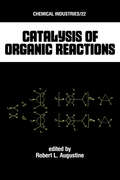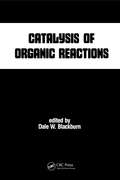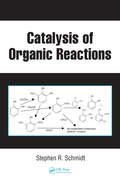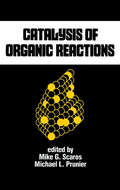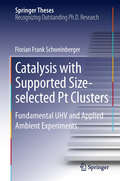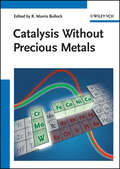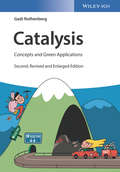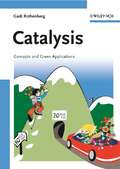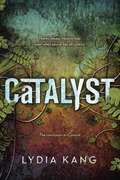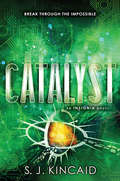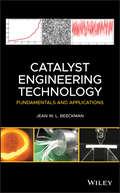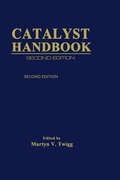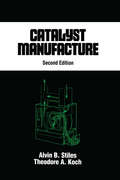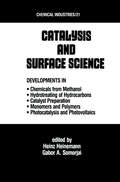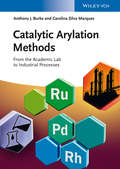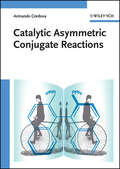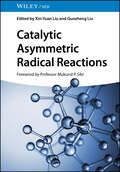- Table View
- List View
Catalysis of Organic Reactions
by Michael E. FordThis volume documents developments in the study of catalysis relating to organic synthesis and its application in industrial processes. It surveys a wide range of homo- and heterogeneous catalysis for industrial and pharmaceutical chemicals. It covers enantioselective hydrogenation, catalyzed hydrogens and oxidation, carbonylation, hydroaminomethyl
Catalysis of Organic Reactions (Chemical Industries Ser. #22)
by Robert L. AugustineThis book provides a complete updating of important developments in the study of catalysis as it applies to organic synthesis — with applications in major industrial processes. It covers a broad variety of catalytic processes — both homogeneous and heterogeneous.
Catalysis of Organic Reactions (Chemical Industries Ser. #40)
by Dale W. BlackburnThis volume is a collection of the papers presented at the Twelfth Conference on the Catalysis of Organic Reactions, where all phases of catalysis, including heterogeneous catalytic hydrogenation, catalytic oxidation, homogeneous catalysis, carbonylation, and amination have been discussed.
Catalysis of Organic Reactions: Twenty-first Conference
by Stephen R. SchmidtBringing together academic, industrial, and governmental researchers and developers, Catalysis of Organic Reactions comprises 57 peer-reviewed papers on the latest scientific developments in applied catalysis for organic reactions. The volume describes the use of both heterogeneous and homogeneous catalyst systems and includes original resea
Catalysis of Organic Reactions: Twenty-second Conference (Chemical Industries Ser. #62)
by Mike G. Scaros Michael L. PrunierBased on the papers and posters presented at the 15th Conference on Catalysis of Organic Reactions, this work covers developments in the study of catalysis as it relates to organic synthesis, emphasizing applications in industrial processes. Over 1000 bibliographic citations and over 250 tables, drawings, and photographs are provided. Theoretical and practical aspects of the field are highlighted.
Catalysis with Supported Size-selected Pt Clusters: Fundamental UHV and Applied Ambient Experiments (Springer Theses)
by Florian Frank SchweinbergerIn his thesis, Florian Schweinberger investigates the influence of the precise size of catalytically active species on reactivity. In order to do this he carries out studies both in UHV and under ambient conditions for supported, size-selected Platium clusters (8-68 atoms). Schweinberger probed the electronic structure, adsorption properties and reactivity of two olefins on surfaces and Pt clusters in the submonolayer range. With adsorbed trichloroethene (TCE) a possible cluster-adsorbate induced change in the electronic structure, and for ethene a low-temperature, size-dependent self-/hydrogenation was observed. In a collaborative approach, Schweinberger and colleagues investigated Pt clusters under ambient pressure conditions. They characterised the clusters at at the local and integral level and tested for temperature stability. Experiments in gas phase ?-reactors and in liquid, as part of a hybrid photocatalytic system, revealed size-dependent reactivity. Overall this thesis is not only of interest for those who want to perform similar experiments but also provides superb scientific insights for researchers in the field.
Catalysis without Precious Metals
by R. Morris BullockWritten for chemists in industry and academia, this ready reference and handbook summarizes recent progress in the development of new catalysts that do not require precious metals. The research thus presented points the way to how new catalysts may ultimately supplant the use of precious metals in some types of reactions, while highlighting the remaining challenges. An essential copanion for organic and catalytic chemists, as well as those working with/on organometallics and graduate students. From the contents: * Catalysis Involving the H' Transfer Reactions of First-Row Transition Metals * Catalytic Reduction of Dinitrogen to Ammonia by Molybdenum Complexes * Molybdenum and Tungsten Catalysts for Hydrogenation, Hydrosilylation and Hydrolysis * Iron in Catalytic Alkene and Carbonyl Hydrogenation Reactions * Olefin Oligomerizations and Polymerizations Catalyzed by Iron and Cobalt Complexes * Cobalt and Nickel Catalyzed Reactions Involving C-H and C-N Activation Reactions * Development of Molecular Electrocatalysts for H2 Oxidation and Production Based on Inexpensive Metals * Nickel-Catalyzed Reductinve Couplings and Cyclizations * Copper-Catalyzed Ligand Promoted Ullmann-Type Coupling Reactions * Copper-Catalyzed Azide-Alkyne Cycloaddition * "Frustrated Lewis Pairs": A Metal-Free Strategy for Hydrogenation Catalysis
Catalysis: Concepts and Green Applications (Second, revised and enlarged edition)
by Gadi RothenbergAfter the great success now in its 2nd Edition: This textbook covers all aspects of catalysis, including computational methods, industrial applications and green chemistry
Catalysis: Concepts and Green Applications (Vor Natuurwetenschappen, Wiskunde En Informatica Ser. #337)
by Gadi RothenbergThis introductory textbook covers all aspects of catalysis. It also bridges computational methods, industrial applications and green chemistry, with over 700 references. The author, a renowned researcher in catalysis, teaches scientific writing as well as chemistry. This makes him the ideal person to write such a textbook. The effectiveness of his practical approach has been well proven in courses for undergraduates and graduates (in 2007 he was voted "lecturer of the year" by the chemistry students). Following an introduction to green chemistry and the basics of catalysis, the book covers biocatalysis, homogeneous catalysis and heterogeneous catalysis, as well as computer applications in catalysis research. Each chapter also features integrated exercises that help students prepare for their exams.
Catalyst
by Lydia KangFor fans of Uglies and The Maze Runner comes a complex, thrill-filled love story that will make you question exactly what it means to be humanIn the past year Zel lost her father, the boy she loves, her safety, and any future she might have imagined for herself. Now she, her sister, and the band of genetic outcasts they've come to call their family are forced on the run when their safe house is attacked by men with neural guns. But on the way to a rumored haven in Chicago, Zel hears something--a whisper from Cy, the boy who traded himself for her sister's safety. And when she veers off plan in order to search for him, what she finds is not what she expected. There's more to their genetic mutations than they ever imagined...aspects that make them wonder if they might be accepted by the outside world after all.
Catalyst (The Insignia Novels #3)
by S. J. KincaidS. J. Kincaid has created a fascinating dystopian world for Insignia, her futuristic science-fiction adventure series perfect for fans of Ender's Game. Earth is in the middle of WWIII, battling to determine which governments and corporations will control the resources of the solar system.Teen Tom Raines grew up with nothing, some days without even a roof over his head. Then his exceptional gaming skills earned him a spot in the Intrasolar Forces, the country's elite military training program, and his life completely changed. Now, in Catalyst, the explosive series conclusion, dangerous changes have come to the Pentagonal Spire, where Tom and his friends train. When a mysterious figure starts fighting against the evil corporations' horrifying plans, but with methods Tom finds shocking, he must decide which side he's on.With slim odds of success, is it even worth the fight?
Catalyst Engineering Technology: Fundamentals and Applications
by Jean W. BeeckmanThis book gives a comprehensive explanation of what governs the breakage of extruded materials, and what techniques are used to measure it. The breakage during impact aka collision is explained using basic laws of nature allowing readers to determine the handling severity of catalyst manufacturing equipment and the severity of entire plants. This information can then be used to improve on the architecture of existing plants and how to design grass-roots plants. The book begins with a summary of particle forming techniques in the particle technology industry. It covers extrusion technology in more detail since extrusion is one of the workhorses for particle manufacture. A section is also dedicated on how to describe transport and chemical reaction in such particulates for of course their final use. It presents the fundamentals of the study of breakage by relating basic laws in different fields (mechanics and physics) and this leads to two novel dimensionless groups that govern breakage. These topics are then apply these topics to R&D scale-up and manufacturing and shows how this approach is directly applicable.
Catalyst Handbook
by Martyn V. TwiggThis book bridges the gap between theory and practice. It provides fundamental information on heterogeneous catalysis and the practicalities of the catalysts and processes used in producing ammonia, hydrogen and methanol via hydrocarbon steam reforming. It also covers the oxidation reactions in making formaldehyde from methanol, nitric acid from ammonia and sulphuric acid from sulphur dioxide. Designed for use in the chemical industry and by those in teaching, research and the study of industrial catalysts and catalytic processes. Students will also find this book extremely useful for obtaining practical information not available in more conventional textbooks.
Catalyst Manufacture (Chemical Industries Ser. #63)
by Alvin B. StilesThis work provides a practical, step-by-step guide to the preparation, production and operation of all commercially used catalysts, taking into account general safety considerations and up-to-date regulations from the Occupational Health Administration and the Environmental Protection Agency. This second edition contains updated and expanded material on the regeneration, reactivity and recovery of used catalysts; problems related to environmental catalysis; a unique CO oxidation catalyst; and more.;This work is intended for chemical, plant, automotive, petroleum, fuel and design engineers; and upper-level graduate and graduate students in these disciplines.
Catalyst Preparation: Science and Engineering
by John RegalbutoThis text explores the optimization of catalytic materials through traditional and novel methods of catalyst preparation, characterization, and monitoring for oxides, supported metals, zeolites, and heteropolyacids. It focuses on the synthesis of bulk materials and of heterogeneous materials, particularly at the nanoscale. The final chapters examine pretreatment, drying, finishing effects, and future applications involving catalyst preparation and the technological advances necessary for continued progress. Topics also include heat and mass transfer limitations, computation methods for predicting properties, and catalyst monitoring on laboratory and industrial scales.
Catalysys and Surface Science
by Heinz Heinemann and Gabor A. SomorjaiThe most comprehensive and up-to-date survey of five industrially important areas ofcatalysis, Catalysis and Surface Science focuses on chemicals from methanol ... hydrotreatingof hydrocarbons . . . catalyst preparation ... monomers and polymers ... andphotocatalysis and photovoltaics.In each of these significant topics, this useful collection of articles traces state-of-the-artdevelopments in fundamental science ... in current exploratory and applied research ...and in current technology. It outlines future trends in catalytic research and technology,and gathers together and synthesizes-into one, single, handy reference-the informationcontained in voluminous, widely scattered articles, books, and patents. As added referencefeatures, this authoritative source provides a wealth of illustrations, including photographs,charts, tables, and line drawings .. . plus useful, detailed bibliographies for further research.Written by 32 leading authorities on all aspects of catalysis, Catalysis and Surface Scienceis essential reading for chemical, industrial process, petrochemical, and electronicengineers, as well as industrial, polymer, and materials chemists. It is also a useful text forgraduate students in chemistry and chemical engineering.
Catalytic Air Pollution Control
by Robert J. Farrauto Ronald M. Heck Suresh T. GulatiCatalytic Air Pollution Control: Commercial Technology is the primary source for commercial catalytic air pollution control technology, offering engineers a comprehensive account of all modern catalytic technology. This Third Edition covers all the new advances in technology in automotive catalyst control technology, diesel engine catalyst control technology, small engine catalyst control technology, and alternate sustainable fuels for auto and diesel.
Catalytic Arylation Methods
by Carolina Silva Marques Anthony J. BurkeA current view of the challenging field of catalytic arylation reactions. Clearly structured, the chapters in this one-stop resource are arranged according to the reaction type, and focus on novel, efficient and sustainable processes, rather than the well-known and established cross-coupling methods. The entire contents are written by two authors with academic and industrial expertise to ensure consistent coverage of the latest developments in the field, as well as industrial applications, such as C-H activation, iron and gold-catalyzed coupling reactions, cycloadditions or novel methodologies using arylboron reagents.A cross-section of relevant tried-and-tested experimental protocols is included at the end of each chapter for putting into immediate practice, along with patent literature. Due to its emphasis on efficient, "green" methods and industrial applications of the products concerned, this interdisciplinary text will be essential reading for synthetic chemists in both academia and industry, especially in medicinal and process chemistry.
Catalytic Asymmetric Conjugate Reactions
by Armando CórdovaThis unique and long-awaited handbook on this important topic in the hot field of stereoselective organic synthesis covers several types of nucleophiles. Top international authors deal with modern forms of achieving stereoselective conjugate additions based on the use of chiral auxiliaries or asymmetric catalysis, such as P-N ligands, organocatalysis, domino reactions, Lewis acid and base catalysis. There is also a discussion of the employment of enantioselective conjugate addition transformations in total synthesis of important molecules. With its reliable and previously unpublished experimental procedures, this is a true source of high quality information.
Catalytic Asymmetric Radical Reactions
by Xin-Yuan Liu Guosheng LiuStrategies to develop catalytic asymmetric radical reactions, from metal-based methods to organocatalytic systems Catalytic Asymmetric Radical Reactions systematically and comprehensively summarizes the development of different strategies to realize asymmetric radical reactions, from metal-based methods to organocatalytic systems. The book starts with the background introduction of this topic and emphasizes the significance and challenge of the stereocontrol over the radical intermediates. Subsequently, it describes the detailed strategies to realize the asymmetric radical reactions, demonstrating how the design of chiral catalysts and substrates helps to achieve the asymmetric induction. Finally, it summarizes the developed strategies and presents a perspective in future development of asymmetric radical reactions. Catalytic Asymmetric Radical Reactions includes information on: Earth-abundant transition metal (e.g., iron, cobalt, nickel, copper, and manganese)-catalyzed asymmetric radical reactions Photoredox/earth-abundant metal-catalyzed asymmetric radical reactions and precious transition metal-catalyzed asymmetric radical reactions Chiral Lewis acid-catalyzed asymmetric radical transformations and chiral-at-metal complex-catalyzed asymmetric radical reactions Organocatalysis via covalent bonds and hydrogen bonding for asymmetric radical transformations Covalent interaction (S/Sn/B-centered radical)-induced asymmetric radical reactions Catalytic Asymmetric Radical Reactions is a timely reference for researchers in academia and industry working in the fields of organic synthesis, drug discovery, and materials science.
Catalytic Asymmetric Reactions of Conjugated Nitroalkenes
by Irishi N.N. Namboothiri Meeta Bhati Madhu Ganesh Basavaprabhu Hosamani Thekke V. Baiju Shimi Manchery Kalisankar BeraNitroalkenes have often been referred to as "synthetic chameleons" owing to their reactivity, synthetic utility and biological significance. In the last two decades, the reactivity of nitroalkenes as substrates in diverse catalytic asymmetric transformations has been of tremendous interest on account of the powerful abilities of the nitro group to coordinate and withdraw electrons, as well as its amenability to undergo a wide variety of synthetic transformations. Although numerous original articles and reviews have appeared in the literature, a monograph providing a comprehensive coverage of this topic was conspicuous by its absence. This book features: A systematic, up-to-date, in-depth and well-organized compilation, spread over 12 chapters, of various catalytic asymmetric reactions of nitroalkenes with diverse substrates reported to date A wide coverage of reactions such as Michael additions, Friedel–Crafts reactions, cycloadditions, asymmetric reductions, multicomponent and cascade reactions, as well as other miscellaneous reactions Various chiral organo, metal and even biocatalysts involved in the stereoselective synthesis of multifunctional adducts via catalytic asymmetric reactions of nitroalkenes Schemes and figures detailing all the reagents, reaction conditions and product profiles Mechanistic details, including transition state models, which will be useful for effective catalytic design This book will be an invaluable resource for those who are working in the area of asymmetric catalysis and synthetic methodologies.
Catalytic Asymmetric Synthesis
by Iwao Ojima Akiyama TakahikoSeminal text presenting detailed accounts of the most important catalytic asymmetric reactions known today This book covers the preparation of enantiomerically pure or enriched chemical compounds by use of chiral catalyst molecules. While reviewing the most important catalytic methods for asymmetric organic synthesis, this book highlights the most important and recent developments in catalytic asymmetric synthesis. Edited by two well-qualified experts, sample topics covered in the work include: Metal catalysis, organocatalysis, photoredox catalysis, enzyme catalysis C-H bond functionalization reactions Carbon-carbon bond formation reactions, carbon-halogen bond formation reactions, hydrogenations, polymerizations, flow reactions Axially chiral compoundsRetaining the best of its predecessors but now thoroughly up to date with the important and recent developments in catalytic asymmetric synthesis, the 4th edition of Catalytic Asymmetric Synthesis serves as an excellent desktop reference and text for researchers and students, from upper-level undergraduates all the way to experienced professionals in industry or academia.
Catalytic Asymmetric Synthesis
by Iwao OjimaPraise for the previous editions"An excellent text . . . will no doubt provide the benchmark for comparative works for many years." --Journal of the American Chemical Society"An excellent state-of-the-art compilation of catalytic asymmetric chemistry . . . should be included in any chemistry reference collection." --Choice"This is a tremendous resource and an excellent read. I recommend immediate purchase." --Perkin TransactionsSince this important work was first published in 1993, the field of catalytic asymmetric synthesis has grown explosively, spawning effective new methods for obtaining enantiomerically pure compounds on a large scale and stimulating new applications in diverse fields--from medicine to materials science. Catalytic Asymmetric Synthesis, Third Edition addresses these rapid changes through contributions from highly recognized world leaders in the field.This seminal text presents detailed accounts of the most important catalytic asymmetric reactions known today, and discusses recent advances and essential information on the initial development of certain processes. An excellent working resource for academic researchers and industrial chemists alike, the Third Edition features:Six entirely new chapters focusing on novel approaches to catalytic asymmetric synthesis including non-conventional media/conditions, organocatalysis, chiral Lewis and Bronsted acids, CH activation, carbon-heteroatom bond-forming reactions, and enzyme-catalyzed asymmetric synthesisA new section focusing on the important new reaction, asymmetric metathesis, in carbon-carbon bond-forming reactionsUpdated chapters on hydrogenation, carbon-carbon bond-forming reactions, hydrosilylations, carbonylations, oxidations, amplifications and autocatalysis, and polymerization reactionsRetaining the best of its predecessors but now thoroughly up to date, Catalytic Asymmetric Synthesis, Third Edition serves as an excellent desktop reference and text for researchers and students from the upper-level undergraduates through experienced professionals in industry or academia.
Catalytic Cascade Reactions
by Wei Wang Peng-Fei XuDemonstrates the advantages of catalytic cascade reactions for synthesizing natural products and pharmaceuticals Riding the wave of green chemistry, catalytic cascade reactions have become one of the most active research areas in organic synthesis. During a cascade reaction, just one reaction solvent, one workup procedure, and one purification step are needed, thus significantly increasing synthetic efficiency. Featuring contributions from an international team of pioneers in the field, Catalytic Cascade Reactions demonstrates the versatility and application of these reactions for synthesizing valuable compounds. The book examines both organocatalysis and transition-metal catalysis reactions, bringing readers up to date with the latest discoveries and activities in all major areas of catalytic cascade reaction research. Catalytic Cascade Reactions begins with three chapters dedicated to organocatalytic cascade reactions, exploring amines, Brønsted acids, and the application of organocatalytic cascade reactions in natural product synthesis and drug discovery. Next, the book covers: Gold-catalyzed cascade reactions Cascade reactions catalyzed by ruthenium, iron, iridium, rhodium, and copper Palladium-catalyzed cascade reactions of alkenes, alkynes, and allenes Application of transition-metal catalyzed cascade reactions in natural product synthesis and drug discovery Engineering mono- and multifunctional nanocatalysts for cascade reactions Multiple-catalyst-promoted cascade reactions All chapters are thoroughly referenced, providing quick access to important original research findings and reviews so that readers can explore individual topics in greater depth. Drawing together and analyzing published findings scattered across the literature, this book provides a single source that encapsulates our current understanding of catalytic cascade processes. Moreover, it sets the stage for the development of new catalytic cascade reactions and their applications.
Catalytic Hydroprocessing of Petroleum and Distillates
by Michael OballaThis work is based on the proceedings of the American Institute of Chemical Engineers' Spring National Meeting in Houston, Texas, March 28 to April 1, 1993. It details various facets of residue upgrading and distillate hydrotreating, stressing the importance of selective catalysts in aromatics reduction. New aromatics saturation processes for the production of very low-aromatic distillates are introduced.

